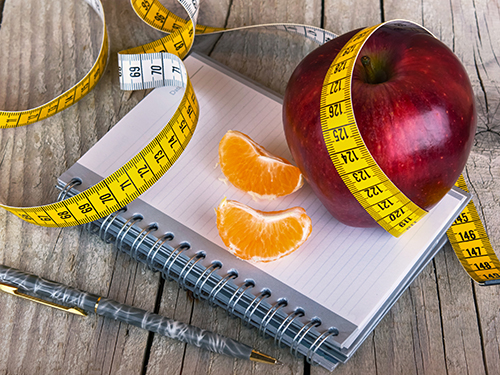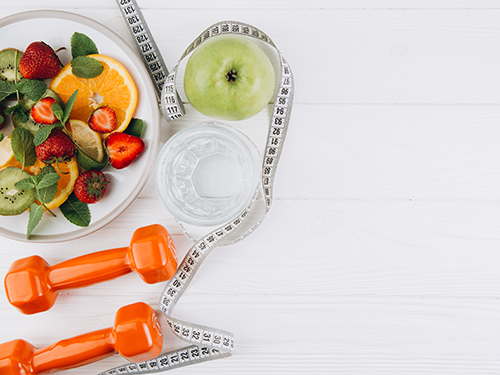
Fact Sheet FS554
What is a Fad Diet?
Fad diet, as defined by the Centers for Disease Control and Prevention (CDC), is any weight loss plan that promises quick results with temporary nutritional changes, the promise of fast weight loss, no need for regularly scheduled exercise, and the intake of limited calories and healthy foods. The major types of fad diets include Low-/No-Carbohydrate Diets, High-Carbohydrate/High-Fiber Diets, Liquid Diets, Very Low-Calorie Diets, and Sole-Intake Diets.
Sort Fact from Fiction about High-Protein Diets
High-protein diets are also called low-carbohydrate diets. Most high-protein diets are also high in fat. High-protein (or low-carbohydrate) diets contain almost no fruits, vegetables, grains, or cereals. These diets are rich in meat, fish, poultry, eggs, nuts, and dairy products. They promote the intake of foods that are high in protein as well as fat and cholesterol.
Diets high in protein and fat are NOT recommended by major health organizations like the American Heart Association, The Academy of Nutrition and Dietetics, Office of the Surgeon General, the Food & Drug Administration, and the United States Department of Agriculture.
Examples of high-protein (low-carbohydrate) diets are the Ketogenic (Keto) Diet, Paleo Diet, Whole 30 Diet, Carnivore Diet, or South Beach Diet. New fad diets are continually being introduced that are essentially the same as other high-protein diets, but with a different name.
Many of these diets become popular because of sizable initial weight loss. Because high-protein diets are low in carbohydrates, they tend to promote urine output, which causes the loss of water weight. This diuretic effect may create a false sense of weight loss. When a normal diet is resumed, water weight is regained.
During the first two weeks on a high-protein diet, the carbohydrate intake is lower than normal, and some body fat is burned. However, carbohydrates are necessary for proper body functions like energy production, energy storage, proper glucose usage, and muscle tissue health. Without carbohydrates, the body does not burn fat completely, and substances called ketones are formed and released into your bloodstream. This condition called ketosis may make restricting calories easier because it often depresses your appetite and may even cause nausea. Ketosis is the body's way of adapting to a shortage of carbohydrates. It can be hard to sustain and is unhealthy long term. Eating high-fiber foods and those rich in folic acid, such as green leafy vegetables and fruit, lowers heart disease risk. Also recommended are whole grains and dairy products with little or no fat content.
Ketosis is NOT a normal state for the body and may cause dehydration, dizziness, constipation, weakness, irritability, bad breath, and headaches. After a few weeks, the high levels of uric acid produced by the kidneys during ketosis may increase the risk of gout or kidney stone flare-ups. Authors of these high-protein diets actually advise consumers to "take advantage" of ketosis to hasten weight loss, but ketosis is one of the body's last-ditch emergency responses. During pregnancy, ketosis may cause abnormal development of the baby or death. For these reasons, the state of ketosis can be dangerous. Plus, it will not lead to permanent, healthy weight loss.
Why is a High-Protein Diet Unhealthy Over Time?
Over an extended period of time, high-protein (low-carbohydrate) diets can cause other health risks. For example, these diets contain too little fiber, which may cause constipation and other intestinal problems. Other risks are described below.
Heart Disease Risk
Heart Disease Risk increases when consuming a diet high in animal protein, cholesterol, and saturated fat. All three raise serum cholesterol and Low Density Lipoprotein (LDL) or "bad cholesterol." A high meat intake may increase homocysteine, an amino acid that increases in the blood stream when levels of dietary protein are up. High homocysteine levels may lead to clogged arteries and heart disease.
Long-Term Weight Loss
Long-Term Weight Loss is not maintained on fad diets because the type and variety of food suggested is usually limited and may lead to boredom and cravings over time. These diets may lead to bingeing on foods high in sugar and fat and backsliding into old habits.
Gout
Gout may be caused by an increased intake of meats, poultry, nuts, seeds, eggs, and seafood that are high in compounds called purines. High amounts of purines in the diet cause uric acid levels to rise in the body. When uric acid levels increase, susceptible individuals may experience joint pain.
Kidney Stones and Gout
Kidney Stones and Gout, in susceptible individuals, may be caused by both uric acid and calcium oxalate stones, which are likely to form on a high-protein, ketogenic diet.
Osteoporosis
Osteoporosis may develop when diets contain excess protein from animal sources, which increases calcium loss in the urine. Low-fat and nonfat dairy products are high-protein foods that contain rich sources of calcium, phosphorus, and Vitamin D and are helpful in providing adequate calcium to reduce the risks of this condition.
Fainting
Fainting or a rapid drop in blood pressure is often caused by loss of fluid and electrolytes when following a high-protein diet.
Bad Breath or "Keto Breath"
Bad Breath or "Keto Breath" is caused by high-protein, low-carbohydrate diets and the incomplete breakdown of fatty acids.
Tips for Sound Weight Loss that Work
Exercise
150–300 minutes of moderate cardiovascular exercise each week is recommended for adults with an additional two days that include muscle strengthening activities. If you are not currently exercising walking is a good place to start, it's free and can be done anywhere. Weightlifting or resistance bands are examples of strength training exercises. Moving more and sitting less burns calories, improves mental health, aids sleeping, and assists with weight loss. Always consult a healthcare professional before starting a new exercise routine. If you are already moving, try increasing the intensity level of workouts for improved weight loss results.
Drink Water
Water is calorie free and keeps you hydrated. If you don't enjoy water add a splash of fresh lemon or lime juice so you drink more water.
Eat Breakfast
Eat whole grain cereal, fruit and fat-free milk for increased energy and alertness in the morning. Avoid high-sugar and high-fat foods.
Persistence
Make exercise and mealtimes a MUST each day. Healthy habits for a lifetime requires daily effort on your part and will make maintaining a healthy weight a reality.
Eat at Home
As often as possible make meals at home to have more control of your food intake. Plan meals and snacks to include foods from the five food groups that are low in fat, salt, sugar, and calories. If you do eat out, bring home leftovers, and avoid eating the large portions served at restaurants. Use smaller dishes at meals and don't have second helpings. Put leftovers away quickly. Plan meals a week ahead, prepare and use a list for weekly supermarket shopping.
Follow the MyPlate Guidelines
MyPlate is an easy-to-follow diagram that is used for creating healthy and nutritious meals. MyPlate consists of 4 sections - Fruits and Vegetables, Grains, Protein, and Dairy that represent the five food groups. Using MyPlate will make it easier to control portions and ensure you are eating a nutrient dense meal that is low in fats, salt, and sugar to maintain a healthy weight. My Plate encourages Americans to make half of the grains consumed every day whole grains. It recommends half your plate be fruits, and vegetables and encourages Americans to eat a variety of fruits and vegetables each day to ensure a nutrient dense diet. My Plate also recommends low fat (1%) or fat free dairy at each meal, low fat and fat free dairy has the same amount of calcium but much less fat. Daily protein portions are encouraged at each meal and should include lean and plant-based protein like beans and legumes. Following the recommendations of serving sizes and food groups create an eating plan with adequate nutrients and calories for good health.
Eat Plenty of Fruits and Vegetables
Fruits and vegetables should be eaten at every meal. Replace processed snack foods that lack vitamins, minerals, fiber, and phytochemicals with fruits and vegetables.
Eat Regularly
Waiting too long to eat can cause you to be so hungry that you overeat or binge on high sugar, fatty or salty foods. Eat several healthy, low-fat snacks if more than 5 hours pass before your next meal. As a general rule, try to minimize any long gaps during the day without fuel, keeping in mind that 5–6 hours between meals is the absolute max to keep blood sugar stable. Some people may even need to eat every 3–4 hours for optimal blood sugar management. Before you begin any new diet or exercise plan, be sure to talk to your doctor or registered dietitian who will help you choose the safest approach based on your health history and current medications.
Relax
Overeating for many is caused by stress and overscheduling. Take a deep breath and count to 10 before grabbing that cookie or other high calorie food. Instead, take a short walk or a drink of water.Write it Down
Keep track of your food intake and daily exercise on a calendar or smart phone to determine what is happening with your weight and energy levels. Records are important for you and for your health care professional when seeking guidance.
Understand Science-Based Nutrition
Know about the latest research so that you don't rely on fad diets, celebrities, TV infomercials, advertisements for quick weight loss products, or questionable web sites. For more credible nutrition information on weight loss see the organization's webpages included in this fact sheet.
Nutrition Resources on Diets for Weight Loss
References
January 2024
Copyright © 2025 Rutgers, The State University of New Jersey. All rights reserved.
For more information: njaes.rutgers.edu.
Cooperating Agencies: Rutgers, The State University of New Jersey, U.S. Department of Agriculture, and Boards of County Commissioners. Rutgers Cooperative Extension, a unit of the Rutgers New Jersey Agricultural Experiment Station, is an equal opportunity program provider and employer.



